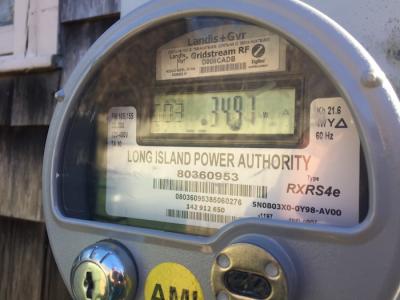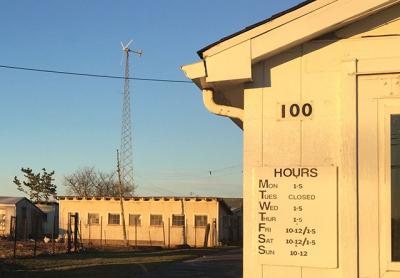Wind Farm Representatives Face Blowback
Wind Farm Representatives Face Blowback
As a deadline looms for the submission of applications to federal and state agencies, Deepwater Wind, the Rhode Island company seeking to construct a 15-turbine wind farm approximately 36 miles east of Montauk, is facing headwinds from commercial fishermen and their representatives, who are concerned that the installation could disrupt the industry and threaten marine life, habitats, or migration patterns.
The East Hampton Town Trustees harbor management committee held a nearly four-hour meeting on Friday night, at which two consulting scientists for Deepwater Wind presented data from an ongoing study of the Block Island Wind Farm, a five-turbine installation that began operating in December 2016, and at which Gary Cobb, who ran unsuccessfully for town trustee in November and acts as a representative of inshore fishermen, spoke.
The scientists called concerns that electromagnetic frequencies from the proposed South Fork Wind Farm’s transmission cable would impact human or marine life unfounded.
Fishermen, who apparently are unconvinced, have urged the trustees, who have jurisdiction over many of the town’s beaches and waterways, to deny an easement over the ocean beach in Wainscott where Deepwater Wind has proposed landing the transmission cable. A Deepwater Wind official suggested on Friday that the company would seek a landing on state property on Napeague if the trustees were not agreeable to Beach Lane, Wainscott.
At the trustees meeting on Monday, Mr. Cobb read a summary of a position statement. Saying that fishermen were economic stakeholders in the town’s near-shore fisheries as well as utility ratepayers, he read: “We stand unanimously opposed to the project.” The need for additional energy sources to meet current or foreseeable future demand is “highly questionable,” he said. Deepwater Wind, he charged, has not adhered to the Bureau of Ocean Energy Management’s best management practices with respect to development and implementation of a local fisheries communication and outreach plan.
Further, Mr. Cobb said, Deepwater Wind has not provided data that would alleviate concerns about the potential impact of the transmission cable. He referred to William Bailey, a consultant who had presented data on the electromagnetic field emanating from the proposed South Fork Wind Farm’s transmission cable, as a pseudoscientist.
Instead of offshore wind, Mr. Cobb argued, rooftop solar, battery storage, LED lighting, and “smart” thermostats are effective means of generating electricity and reducing demand that would not threaten the ocean and those that make their living on it. It would be irresponsible for any governing body to support “any environmentally invasive project that was based on questionable need,” Mr. Cobb concluded. He also said it was indefensible given what he claimed was Deepwater Wind’s failure to provide site or project-specific data critical to assessing the project’s potential impacts on the marine environment.
“We don’t know enough about this yet,” he told the trustees. “The precautionary principle should be adhered to,” he said. “Without a baseline of data, how do you even prove impact to the fishery. . . . Maybe it won’t have any impact at all, but you need to be able to say that with at least some assurance.”
Deepwater Wind officials have repeatedly and emphatically stated that the South Fork Wind Farm would pose no threat to marine life or to fishermen, and that its ongoing, six-year study of the Block Island Wind Farm has demonstrated no detrimental impacts to date.
To the question of need, Clint Plummer, Deepwater Wind’s vice president of development, said yesterday that the Long Island Power Authority “has been very clear about the need, not for new power islandwide” but for “certain areas where it is very difficult to deliver power to,” referring to the South Fork and western Nassau County. “In 2015 and 2016, LIPA ran two competitive solicitations,” he said. “In the case of the South Fork, it found the most cost-effective solution was the portfolio that included Deepwater Wind and battery storage.”
Deepwater Wind adheres to the best practices, according to Aileen Kenney, the company’s vice president of permitting and environmental affairs, who pointed to a Jan. 10 forum in Montauk and the April 2017 posting for a Long Island fisheries representative.
“We continue to build upon our experiences at Block Island Wind Farm and develop a successful, worthwhile program based on BOEM’s best practices,” she said.
Rick Drew, the deputy clerk of the trustees and member of its harbor management committee, has voiced increasing frustration with what he considers insufficient data from Deepwater Wind. On Monday, he said it was clear “that there was a lot of information missing from the presentation” on Friday night. “I thank the Deepwater Wind team for bringing scientists, but clearly . . . there are some pretty big holes to fill” before the trustees and fishermen are satisfied. The committee intends to make a recommendation about whether to support the wind farm, but Deepwater Wind must provide more information, he said.
Mr. Plummer said the process was complicated, but that as people learn more they will become more comfortable with it. “We’re building a new industry,” he said yesterday, “and going through a lot of new processes that have never been done for projects like this before. In a typical process you would have a fully engineered project, they would then bring a full slate of plans and environmental review to a board that has some jurisdiction, and that board would then review it and make a decision based on the merits.”
Deepwater Wind has engaged with the community well in advance of submitting permit applications, “because we want feedback from the community and think it results in a better project,” Mr. Plummer said. The company’s request to the town and trustees for easements to route the transmission cable to a LIPA substation in East Hampton “is not a final request,” he said, but “we need to know we have all of our municipal real estate rights established” in order to proceed. “This is a request to be able to start a process,” he said.
In other news at the meeting, the trustees called an executive session to debate the selection of a new attorney, emerging with Chris Carillo as their choice. Richard Whalen has represented them for the last two years and had informed them that he would step down at the end of last year.
Meanwhile, Francis Bock, the trustees’ clerk, told his colleagues that the State Department of Environmental Conservation has issued a 10-year permit to dredge the south inlet of Georgica Pond, a project intended to improve circulation. An application to the Army Corps of Engineers is pending, Mr. Bock said, and was posted for public comment last Thursday. The public comment period will conclude next Thursday. “Hopefully, we will receive their permit forthwith,” he said.







